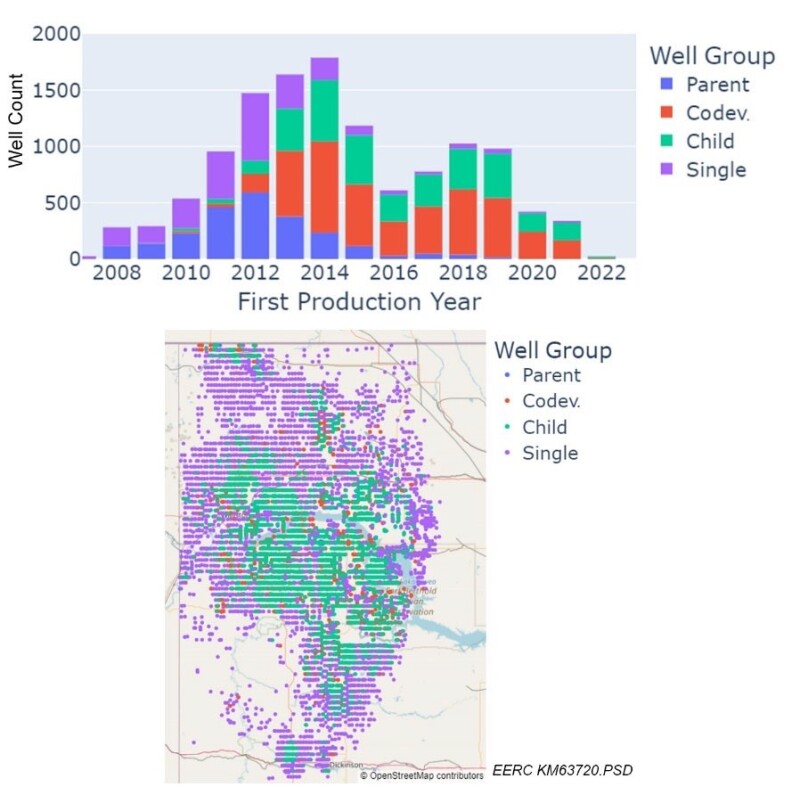Well-to-well interactions in North Dakota’s Bakken Shale stand out in one big way from those in most other unconventional plays. Whereas frac hits generally hurt production in older parent wells elsewhere, they often improve it in Bakken.
Over the years, the question has lingered—why?
One theory suggests that the Bakken's unique geologic properties, particularly its proclivity for long planar fractures, is responsible. And there may very well be a geologic linkage, but new research shared at the recent Unconventional Resources Technology Conference (URTeC) argues that there is a little more to the story.
Kyoung Suk Min of the Energy and Environmental Research Center (EERC) in North Dakota elaborates: “The reason why Bakken operators have historically not seen much production loss from the parent-child effect is because their initial completion designs were small, suboptimal, and understimulated.”
Min, a reservoir engineer and data scientist, along with his EERC colleagues, authored the conference paper URTeC 3862589 which concluded that understimulated wells are the chief driver of beneficial frac hits in the Bakken. The research team used machine learning models to analyze data from over 17,000 horizontal wells, nearly half of which were determined to have been impacted by parent-child interactions.
Among the study’s biggest insights is that the most beneficial frac hits were seen in parent wells with proppant loadings of less than 450 lb per lateral ft—and that 83% of all parent wells in the Bakken fall below this critical threshold.
Then there is the other side of the equation. The EERC found that when a child well’s proppant loading surpassed 1,000 lb/ft, the adjacent parent wells saw production surge by an average of 123% over the 90-day post-stimulation period.
Others have looked at the issue and suggested a similar link. In URTeC 3868861, also published this year, authors from the University of Wyoming and Texas A&M University examined a smaller subset of parent-child wells that showed clear signs of fracture interactions.
While noting that most of the wells analyzed did not show a “strong correlation,” the researchers highlighted that the lower a parent well’s initial production rate, the higher it’s post-frac-hit production tended to be. “This can be explained in terms of stimulating the parent wells which were potentially understimulated prior to [a] child’s completion.”

What We Didn’t Know Then
Most of the Bakken’s understimulated parents were completed between 2010 and 2015, the EERC found, which Min said represents a period of general stagnation for well design in the region.
A typical proppant loading during this time was anywhere between 200 to 400 lb/ft. By 2016, the average figure soared to more than 900 lb/ft and remains in that neighborhood today.
Additional context is found in the fact that the Bakken was the first tight-oil play to see significant development a decade ago, which means its first explorers were at a disadvantage when it came to climbing the learning curve.
Min contrasts this with the experience shared elsewhere, noting, “If you look at the Permian or other basins, the initial completion sizes of the parent wells were larger—they are closer to what new child wells in the Bakken look like.”
A point this raises is that production-boosting frac hits will soon become a thing of the past as the number of understimulated parents continues to shrink while new parent wells—as short in supply as they may be—are using the larger stimulation designs.
Yes, Well Spacing Matters Too
In addition to proppant volume, well spacing is the other key factor that decides the magnitude of the well-to-well interactions. The EERC analysis shows that as well spacing falls below 800 ft, the interactions become stronger and the risk to child well productivity grows.
To illustrate, the EERC posits that a child well in the Bakken pumped with 1,300 lb/ft and landed 400 ft from a parent wellbore stands to suffer a production shortfall of 40,000 bbl over its first year of life.
Operators in the region have responded by backing away from parent wells while reserving tight spacings for child-child well pairings. EERC shows that average parent-child spacing is a little over 700 ft today while child-child wells are closer to 580 ft apart on average.
Rethinking Refracturing
Another implication of the findings involves the future of refracturing for Bakken operators. Some operators are turning to refracturing parent wells as a protection measure for the parent, but also for the child well which needs its fractures to crack open new rock.
However, results reported by the EERC do not add up to a strong endorsement of the practice for mitigation reasons. They suggest refracturing can be a mitigating tool but only at relatively tight well spacings and even then, the net impact may not be impressive.
Per the paper: “In child wells interacting with refractured parent wells, when well spacing ranged from less than 400 ft to greater than 1,200 ft, the child- well production impact ranged from −9 to +5%, respectively. In contrast, in child wells where there was no refractured parent well, when well spacing ranged from less than 400 ft to greater than 1,200 ft, the child well production impact ranged from −15.4 to +0.6%, respectively.”
Min added that the figures show refracturing offers “some but not a lot” of value as a protective measure.
The EERC is continuing to study this aspect and others since refracturing is hoped to play a major role in the aging tight-rock play's future.
For Further Reading
URTeC 3862589 Data-Driven Analysis for Causality of Parent–Child Interactions in the Bakken by Kyoung Suk Min, Alexander V. Chakhmakhchev, Xue Yu, Nicholas A. et al., the Energy & Environmental Research Center.
URTeC 3868861 Identification and Quantification of the Effect of Fracture-Driven Interactions on Production from Parent and Child Wells in Williston Basin by Abdeldjalil Latrach, University of Wyoming; Ahmed Merzoug, Texas A&M University; and Cilia Abdelhamid, et al., University of Wyoming.


